Yamaha Champions Riding School Review
A pilgrimage to the temple of trailbraking
Having grown up in a gearhead household, I was fortunate enough to be surrounded with bikes and cars from a very young age. My father split his weekends between teaching my brother how to ride enduro bikes and teaching me how to get faster in go-karts. The constant theme was one of being the best you can at operating your power toys, and surrounding yourself with people who can teach you how to get better, faster and safer along the way.
As a teenager I followed my father’s footsteps into the local BMW (car) Club, where I graduated from student to Instructor in a few short years. The lessons I learned during that developmental period served me well as I moved into touring car racing, where I was always able to wring the most out of my equipment and avoid expensive catastrophes along the way. I was a firm believer in the value of professional instruction.
As I moved out of auto racing and searched for a suitable replacement that would stimulate my horsepower gland, I drifted back towards motorcycles. My brother was nudging me along, eager to have me share in the weekend thrills he was savoring on his Aprilia Dorsoduro 750.
I jumped back into the sport after 20 years away by picking up a BMW F800R and very quickly realizing that I was in over my head. Courting disaster, I’d chase my more experienced buddies through the rural routes of Ontario, never experiencing the comfort and confidence at speed that I’d always enjoyed in high-performance cars. Riding a motorcycle quickly and safely was a dance that was foreign to me. While it shared some of the physics and principles of auto racing, it required a very different skillset.
I decided in that first season that I’d spend some time and money every one or two years to improve my skills by spending time at the track with professional coaches. I located the nearest school – the only school – near my Toronto home and signed up for a two-day course. It was an eye-opener and it transformed my riding. It also reinforced how much you can learn in a track environment and it made me hungry to learn more.
Two years later I decided I’d try a different big-name school in the U.S. The experience was much different and I was left disappointed. Unlike my previous school event, there was little discussion of braking or downshifting, and the course was essentially a free-for-all where 90% of the curriculum revolved around “vision” and getting as close to the pylons as possible without running off the track.
Undeterred, I continued my search for the next school I’d attend. Around that time I began following the Yamaha Champions Riding School (YCRS) on social media and I was captivated by their focus on braking as the critical component that is required to be a faster, safer and more skilled rider. Chief Instructor Nick Ienatsch used his decade-plus years at the Freddie Spencer High Performance Riding School as the basis for YCRS. After watching a few more testimonial and coaching videos, I was sold. YCRS had started offering winter courses at Inde Motorsports Ranch in Arizona, which would make for a perfect escape from the Toronto winter. I booked a two-day course and bought a ticket to Tucson.
In the middle of the desert outside Willcox, Arizona, I found the Inde Motorsports Ranch. I made my customary night-before visit to the facility and I was shocked by what I found. Inde is a private facility where members store their high-performance toys and use the track when the mood strikes. Carefully manicured xeriscapes surround sparkling garages filled with all manner of exotic cars: Ariel Atoms, retired Indy cars and Italian exotics were precisely lined up on spotless epoxy floors. The grounds were dotted with decommissioned fighter jets on pedestals – this was no a run-of-the-mill racetrack.
I was greeted by Keith Culver, YCRS’s Chief Operating Officer. He was writing student names on each of 16 immaculate Yamaha R6s. No bike sharing here – each student is assigned their very own R6 for the event. It’s a small detail, but there is peace of mind in knowing that nobody will crash your bike. You also don’t need to adjust to any nuances between bikes as you would if you were sharing bikes with other riders.
Off to one side, there was also an assortment of 2016 Yamaha product including an FZ-07, FZ-09, R3, several R1s, and a handful of FZ1s that the course instructors would ride on track. Toward the end of Day 2, students would be given the chance to sample whichever bikes they chose – smart marketing by the folks at Yamaha USA.
Day 1 began with introductions to the Instructor team. Chief Instructor Ienatsch was joined by regulars Chris Peris, Mark Schellinger and C.J. Laroche for the course, along with support from other coaches. In the classroom, all of the riders introduced themselves to the room and were divided into small groups according to experience level and past track experience. Instructor to Student ratio ended up being 1:4, ensuring that coaching would be intensive. Several novice riders ended up with 1:1 coaching, a luxury afforded them by additional instructors that YCRS has on-hand to pitch in where required.
The YCRS philosophy is that if you want to ride like a champion, you need to emulate the techniques of the world’s top racers and riders. One of the cornerstones of world-class riding technique is efficient and effective braking, particularly the reliance on the front brake to set speed and direction from first application to the apex of a corner (and beyond where the situation requires).
The course theory starts with what Ienatsch calls “the umbrella of direction,” directly related to the available traction a tire can provide based on throttle, brake and lean angle inputs from the rider. We are reminded that a tire has 100 “points” of traction to offer the rider. If a rider is using 75 of those points towards lean angle or braking, there are only 25 points remaining for other inputs. Exceeding the 100 points will cause a tire to lose traction, a situation that typically ends in a crashed motorcycle.
Before we were turned loose on the R6s to see the track for the first time, we were piled into a passenger van with Ienatsch at the wheel. The demonstration was enlightening, as we were shown how “sticking with the brakes” until we are happy with speed and direction will enable a smooth transition back to the throttle and a fast corner exit. We were also shown how a rushed corner entry or early turn-in can have disastrous results, as track surface becomes scarce at corner exit. On a motorcycle, that scenario would require the rider to hold a high lean angle to keep the bike on the track, limiting the “points” available to use for throttle and exit acceleration. Definitely not the way that champions ride.
The van ride was the first time most students saw the full Inde track, and it became apparent to the newcomers that 22 turns and nearly three miles of chicanes, blind corners, elevation changes and varying radius turns would keep us very busy over the next two days.
As we were dropped in the paddock and began suiting up for the first of many lead-follow sessions with our coaches, Ienatsch and crew reminded us of a few key points in a final pep talk:
- Always ride with a mantra or plan in mind.
- Remember the 100 points of grip.
- Radius = mph
- Stay with the brakes until we’re happy with speed and direction.
On track, the coaching began as we alternated between chasing our coaches around the track and having them follow us and observe our riding habits. Feedback was direct and immediate – we stopped every few laps on Inde’s double-width straightaway for debriefing and reinforcement. Body position and braking technique were the two key areas of focus, and the finest adjustments resulted in the entire group moving more quickly around the circuit.
MO’s Troy Siahaan helps coach a YCRS school
Once the group was comfortable with the track layout, we began a series of drills that reinforced that effective braking can take place while we were turning in and adding lean angle. Pylons were placed on the track mid-corner, forcing riders to hold, or trail, the front brake until proper direction was set and the obstacle was avoided. Instructors stood at corner apexes, forcing us to a stop while the bikes were carrying significant lean angle. One at a time, all of the common myths about the disastrous effects of braking while turning were dispelled and the art of trail braking was revealing itself.
At varying points during the day, students are invited to hop on the back of a Yamaha FZ1 ridden by an instructor in order to get a front-row-seat demonstration of the principles being taught in the course. I was lucky enough to hitch a ride with Peris, AMA Supersport hotshoe, and I was amazed at the seamless transitions between braking and throttle at terrifying lean angles. True to form, Peris’ laps were identical copies and I’m sure that we covered the same pieces of pavement within inches as we hurtled around the track. The ridealong refocused me on the level of smoothness and controlled aggression that fast riding requires.
One of the most eye-opening tools employed by the crew at YCRS is video analysis. Toward the end of Day 1, students are told to ride their best lap, with an instructor in hot pursuit aboard an FZ1 equipped with a camera. Everyone gets their laps recorded and the results are reviewed in a detailed and honest debriefing session in the classroom. Frame by frame, turn by turn, every student receives feedback from the coaches and encouragement from their fellow riders. Body position, head position, braking points, lean angles, track position and many other details are covered, giving each rider several key areas to focus on during Day 2. Laps are filmed again on Day 2, and the improvements and adjustments between the two days is dramatic for the majority of students in the course.
The YCRS courses are held at two racetrack facilities – New Jersey Motorsports Park in the summer and Inde Motorsports Ranch during winter months – but the overall philosophy of the school extends to all types of riding on both street and track. Ienatsch continually reminded us to take every ride seriously and to always have a plan or mantra in mind. Proper technique is proper technique, regardless of how fast you’re riding, what bike you’re on, or where you’re riding.
Reinforcing the holistic approach to skill development, Peris had us start a list on Day 1 called “Why We Crash.” Over the two-day course we referred back to the list and added additional reasons, summing seven in total that are equally applicable to the street or the track.
- Lack of focus
- Repeating mistakes
- Abruptness
- Rushing corner entry
- Cold tires
- Over-confidence
- Failure to adapt to changing conditions.
The YCRS two-day ChampSchool course costs $2,400 ($1995 if the student brings their own bike) which to me is a relative bargain when considering all it includes: rental of a Yamaha R6 with fuel and fresh tires, hours and hours of track time, world-class coaching, and three freshly prepped meals each day. Students in need of gear can rent quality suits, boots and gloves provided by Alpinestars and helmets furnished by Arai. Alternatively, YCRS also offers single-day classes called ChampDays ($495) and single-day courses aimed at street riders called ChampStreet ($160).
The entire YCRS experience is top-notch, and the large number of returning students is a testimonial to both the quality of instruction and overall atmosphere of the event. I left feeling as though I had joined an alumni group of sorts, and I’m already planning my next visit. I know that I’ve only scratched the surface of my riding development, but I am 100% sold on the YCRS team’s ability to help me reach my potential and become a faster, safer rider.
More by Jordan Marrison



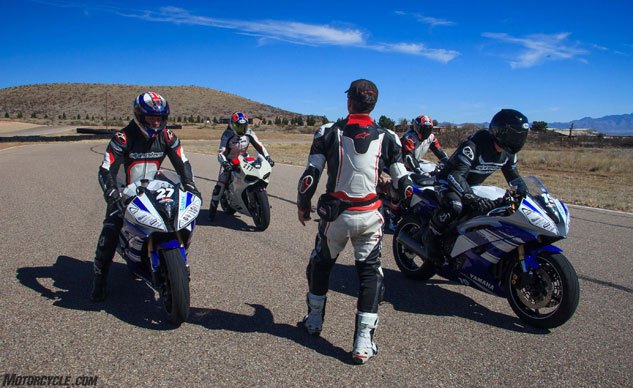



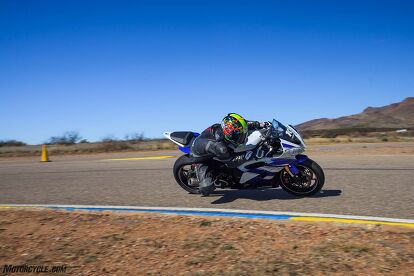




































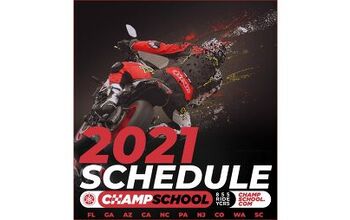

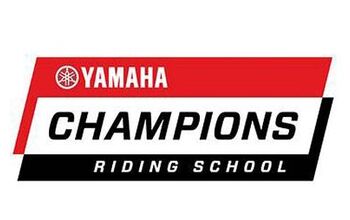
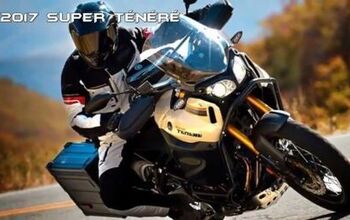
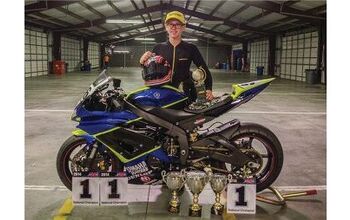



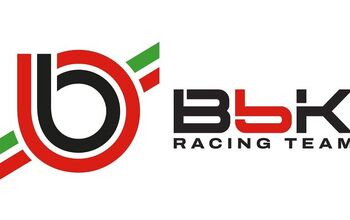







Comments
Join the conversation
Man this looks fun, I have been seriously considering a school recently. Thinking I may go do a flat track school and then one of the superbike schools, that way I can get used to a bike moving under me a bit more before turning up the dial to 11.
A really good read. Thanks Jordan. Made we want to sign up right away but the cost multiplier from NZ is a hurdle.